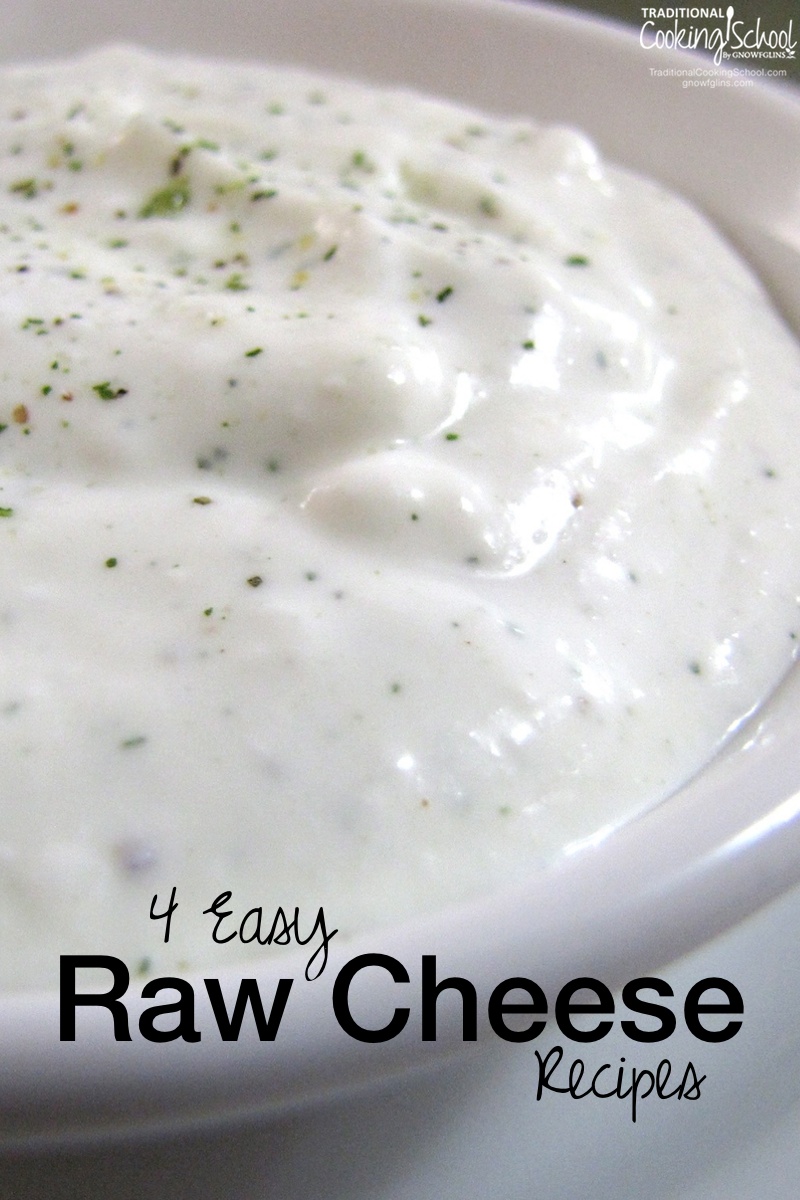
Over the years, we have raised both dairy goats and a Jersey cow. A fantastic benefit of raising your own dairy (or finding a good source of local, raw, pastured dairy) is having extra milk for cheese. (Read here for more on the blessings and privileged of home dairying.)
When we had goats, I didn’t have as much extra milk as I’d like. When we had a cow, I had tons of milk. It’s always a balancing act of what to do with it when you’ve got it. 😉
Usually, my extra milk gets turned into cheese, homemade cottage cheese, kefir, yogurt, homemade buttermilk, or clabber (for the animals). Below is a round-up of the simplest cheese recipes; the ones I make all the time!
4 Easy Raw Cheese Recipes
Are you interested in raw cheese-making? Here is a delicious raw cheddar cheese recipe. I’ve tried a bunch of recipes, and 4 of them I make over and over again.
These are the cheeses that we eat daily (and that also populate my freezer) offering all the benefits of raw cultured milk, such as beneficial bacteria and enzymes. None of these cheeses go over 93 degrees Fahrenheit; they can still be called raw with the enzymes and bacteria intact.
Note: You may use the whey from all these cheeses in your lacto-fermentation and/or soaking.
You’ll find detailed video and print tutorials for all these cheeses in the Cultured Dairy and Basic Cheese class of your Traditional Cooking School membership.
#1 — Chevre or Soft Cheese
My recipe takes off from Fias Co. Farm (like most of the recipes I follow), and it is delicious! We spread it on toast, or use it as the dairy base for a delicious creamy dressing. This is a 48-hour cheese and it pretty much makes itself. 24 hours for culturing, and 24 hours for dripping. I use two layers of 90-count cheesecloth and find no need to hang the cheese up – a colander suspended in a pot works just fine. I have learned a lot about this process since my first attempt and you’ll see all my tweaks in my current recipe (guest posted at Edible Aria).
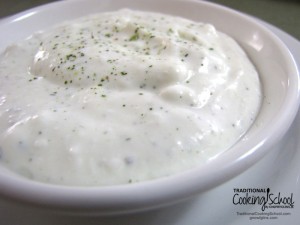
#2 — Kefir Cheese
Whenever we have too much kefir around, it inevitably becomes cheese following a simple dripping process. You can read about it here in my Probiotic Potato Salad recipe — although I no longer find it necessary to hang the bag of dripping kefir.
I drip it through two layers of 90 count cheesecloth in a colander suspended in a pot. This cheese can also be used in the delicious creamy dressing or spread on toast, or seasoned up as a dip for veggies. Yogurt can be turned into a similar cheese.
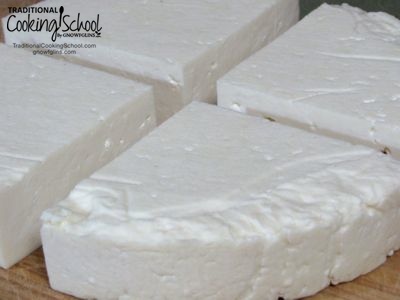
#3 — Queso Fresco
What I really love about this queso fresco cheese is that it is a raw cheese that shreds and melts. I have not made mozzarella or other high-temperature cheeses yet because I hesitate to destroy all the beneficial bacteria and enzymes in raw milk. So for now, I’ve happily settled on this cheese to fill the purpose of a shred-able, melt-able cheese that retains its good enzymes and bacteria. It requires a little extra attention at the cooking stage – you must nurture the curds as they slowly rise in temperature from 86 to 93 degrees F. This cheese does need a press; I use the Tome/St. Paulin mold and follower from The Diary Connection. I weight it down with my husband’s weight-lifting weights – it needs 35 pounds of pressure by the end of the pressing. After pressing, you age it in the refrigerator for 3 days and then it is ready to eat! I’ll be pulling some out of the fridge today that just finished.
You can see this cheese being pressed in this (free) video demonstration of the Ultimate Cheese Press from Homesteader Supply.
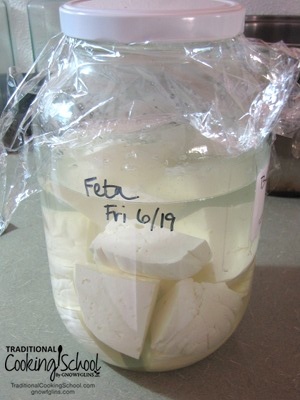
#4 — Feta Cheese
Also from Fias Co Farm, this feta cheese is easy to make. It does stink up the house, just like the author says. This is due to the culturing with calf lipase. One day my husband said he wasn’t sure he wanted to make cheese any more, the smell was so strong. 😉 But it is worth it, we’ve all come to agree. You’ll follow steps of culturing and setting the milk, cutting the curds, firming up the curds at a low temperature while the whey continues to separate out, and then hanging the cheese for 24 hours to harden. Then you cut the feta into chunks and allow it to age for three days before putting it into a salt water brine where it must age for another month. The result is absolutely delicious! You’ve never had feta cheese until you taste a homemade, fresh feta.
I will continue this series in the coming days. We’ll talk about Raw Cheese Benefits (part 3) and Basic Cheese-making Cultures and Supplies (part 2), and anything else that might come up!
Once you’ve made these 4 recipes, here are 15 more easy raw cheese recipes.
Want to learn more about raw cheese-making? Check out a Traditional Cooking School membership which includes access to a complete Cultured Dairy & Basic Cheese eCourse, including dozens of videos and print tutorials for everything from sour cream and yogurt to a variety of simple cheeses.
What cheese do you make or would you like to make? Do you have any questions about anything I’ve shared? What kind of information would you like to know about cheese-making?
...without giving up the foods you love or spending all day in the kitchen!

2 free books:
Eat God's Way
Ditch the Standard American Diet, get healthier & happier, and save money on groceries...
We only recommend products and services we wholeheartedly endorse. This post may contain special links through which we earn a small commission if you make a purchase (though your price is the same).

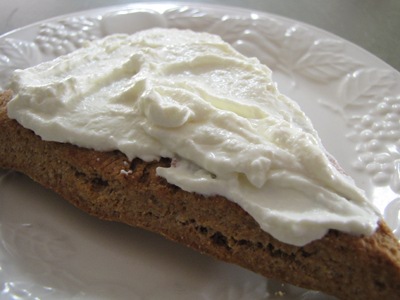

I’m looking forward to trying my hand at cheesemaking once we get a cow (God willing). I will be refering back to this post! I believe you about the awesome taste! I found a source for cheese that is made from organic, unpasteurized milk. The flavour is incredible! Imagine how good homemade would be.
I was *just* looking on your website yesterday for this info! I’ll be back later to check this out in detail. I have extra raw milk this week. 🙂
I wonder if Whole Foods sells cheesemaking supplies? I’ll stop by today to find out.
OH, thank you, thank you, thank you! I’ve been wanting to make cheese for awhile now. I quit working (outside of my home anyway) in December, so now I have more time for things just like this! And……..I have extra milk right now. Does it matter if I use cow’s milk?
Thanks,
Tiffany
Thank you for this post Wardee! I’ve been thinking of cheese lately and wondering if I could/should start making it (other than the kefir and yogurt cheeses I already do). Are there any guidelines for how much cheese a gallon of milk will produce? I’m guessing that each cheese would be fine made with cows milk as opposed to goats milk?
.-= Millie @ Homespun Oasis´s last blog post… Tuesday Twister January 5 =-.
Millie – a gallon of milk produces about a pound of cheese.
Tiffany and Millie – You can use either cow or goat milk in all these recipes. The main difference is that with goat milk (with regard to feta or queso fresco) is that you do the initial culturing at 86 degrees, while with cow’s milk you do it at 88 degrees. It is something like that – and the Fias Co Farm recipes tell you this.
Christie – Let me know if they do please, then I can include that information when I talk about cheesemaking supplies.
Marg – You will love the incredible taste, though I think the cheese you found is probably pretty good. 🙂 I hope you get a cow, and that we get a cow, then we can talk about … cows!
Hi and thank you for your uplifting and educational blog! I haven’t attempted cheese-making yet, but I do use raw cheese for everything, including casseroles. You mentioned that your cheese doesn’t go over 93 degrees. If I heat my cheese in casseroles in a 350 degree oven are part or all of the benefits of cheese being raw destroyed? Is it still better to use raw or should I save money and use pasteurized when baking? Thank you!
Leanne – You don’t retain the enzyme or bacteria benefits when baking in a 350 degree oven. As soon as the cheese hits 118 degrees, the enzymes are gone. I’m not sure exactly when the bacteria dies but certainly well before 350 degrees. I personally don’t think this is a reason to buy pasteurized cheese but that is because I think we should still start with the best ingredients, no matter what we end up doing with them. When I do casseroles or hot food, I usually add the cheese as a topping at the very end, like when serving. This way it doesn’t heat up to the same temperature as the dish and likely more of the benefits are retained. And then sometimes (like for pizza) I will bake the cheese. In our family, baking cheese is the exception, not the norm. Overall, if your diet is full of other sources of probiotics and enzymes then baking your cheese isn’t a great detriment with regard to that. Anyway, those are my thoughts. 🙂
The last time I tried making Feta it didn’t work; I’ll have to try again one of these days. I also haven’t had luck with hard cheese.
I make chevre or goat cream cheese fairly often (I have a recipe for goat cream cheese on my blog). I’ve also made goat’s milk ricotta which was very easy. I recommend Ricki Carroll’s book Home Cheesemaking as well as her supply site http://www.cheesemaking.com. Mozzarella is fun and easy, although it requires a little hands’ on time.
.-= Rebecca´s last blog post… Menu Plan Monday – Week of 1/4/2010 =-.
Ooh I likey. Must try. Seems intimidating but I’m sure it’s not hard!
.-= Michelle @ Find Your Balance´s last blog post… Happy New Year – A Gaiam DVD Giveaway for you! =-.
Excellent post! This past summer was spent looking for ways to make a cheese press. I still plan on making one. I do kefir cheese, labneh & I had tried another but doggone if I can remember the name of it. I’m hoping to expand my horizons!
.-= Michaela Leeper´s last blog post… CHRISTmas Menu 09 =-.
I love & make kefir cheese all the time, but I think I’ll try my hand at this Feta!
Grok – it is amazing feta! Our family was not used to strongly flavored cheese, so we did take a little bit to decide it was awesome. And I wouldn’t say it is ‘strong-strong’, just ‘strong’ for us because we’d only had mild cheese before.
Rebecca – I’ve not made mozarella yet. I bumped into someone yesterday who did for the first time. All the instructions I’ve seen call for a microwave. Do you know of how to do it without? Perhaps Ricki Carroll’s book? I used to have it book but the cheddar recipe I tried didn’t work out for me. I also shopped her site once, but was surprised to find “extra” ingredients in the cultures. “Dextrose” comes to mind, but it was awhile ago.
Michelle – No, not hard in the least! And so worth it. 🙂
Michaela – How are you going to make it? Have you seen the plans at Fias Co. Farm? I would like a cheesepress, too, but I was thinking of buying one one of these days.
I make home made mozarella with raw cow’s milk. 4 cups milk heated to 105 (use a candy thermometer), add 1 cup lemon juice, the curds will immediately begin to form, with a clean hand press gently to side of bowl into a ball, drain in a colander, recipe takes about 5 minutes and you are ready to eat raw vegetarian mozarella! My family loves this cheese on pizza or in salad. Enjoy! Use 1 and 1/2 cup lemon juice for a ricotta like consistency.
Thanks, Kathy!
Wardee, I just went & looked at the directions on how to make one. The ones I’d originally looked at were made of wood or PVC pipes. The PVC pipes I was leary of using, and the wood, I thought, would be a pain to clean/keep clean. Now I’m reading that mineral oil protects the wood, and I’d imagine they mean that it keeps it from being harmed by the acidic whey? Do you have any thoughts on this? Would another (better) oil work better? Thoughts on using PVC? The picture & directions on Fias are a bit vague. Are they using an actual cheese mold? It mentions cheese mold, so I don’t know if this is made or if it’s pre-fab. The pic looks like mason jars, though, LOL.
Sorry to bombard you with questions.
.-= Michaela Leeper´s last blog post… CHRISTmas Menu 09 =-.
Michaela – I don’t think PVC is a good choice, and the wood I want to avoid for the same reason as you. You can use food oils to condition and protect wood – that’s recommend for bamboo cutting boards, so I don’t see why it wouldn’t work here. I am using a plastic mold now, but at least it is hard, food grade plastic, one of the safest plastic choices. The press at Fias Co Farm uses a mold and follower like mine. The plan is to build the pressing part of it. Thanks for your questions! I love to talk about these things. You might want to read my post for today, which talks more about equipment. https://traditionalcookingschool.com/2010/01/07/basic-cheesemaking-cultures-supplies-and-equipment/
Kathe, what do you do with the mozarella after you drain it? Is it ready at that point to eat, or do you have to fold and stretch it?
PANEER!!! It was paneer that I couldn’t recall the name of!!! I wasn’t thrilled with that one, but I also lacked the press. It was too crumbly, but I’ll try again with a proper press or press setup.
.-= Michaela Leeper´s last blog post… CHRISTmas Menu 09 =-.
I didn’t make it to Whole Foods yesterday so I’m sorry I cannot tell you if they carry the supplies.
I’m trying Kathe’s milk and lemon cheese recipe right now since I had exactly 4 cups of raw milk to use up.
Christie – Exciting! I can’t wait to hear how it turns out.
What a great post! I too recently embarked on goat ownership and have struggled with making cheese, mostly because I haven’t found any good recipes I like that keep the milk raw!
This post is a great resource for me…I appreciate you sharing the info in the post! I am looking forward to trying the chevre as I love the idea of a spreadable cheese.
Thanks again!
– RFM
.-= Real Food Mama´s last blog post… Book Review: Animal, Vegetable, Miracle =-.
I made the lemon cheese, and its yummy! I’ve been eating it on a spinach salad, with pine nuts and diced pears, with a drizzle of olive oil. The lemony flavor compliments a salad perfectly!
This is great!! I do make raw cream cheese and kefir cheese, but would love to try the others… especially chevre once we get goats!
Speaking of goats… do you have any advise on getting them, feed and fencing? I would love to hear what you’ve been doing so far. Love your video of the goats too 🙂
Marillyn – How exciting that you’re maybe getting goats soon?! I would love to share what we’ve done, perhaps we can correspond by email? We are still figuring things out and are not experts, just so you know. 🙂
Marillyn – I got to thinking that I should probably refer to some posts I’ve written that have chronicled our goat adventure. 🙂 Maybe not everything is current, because I’ve kind of petered out with my updates, but here’s at least some of how we got started, what we did, and what we’ve learned:
Traditional Diet for Goats – speculations, with an interesting discussion happening in the comments!
https://traditionalcookingschool.com/2009/05/20/traditional-natural-diet-for-goats/
Reflections of a First Time Goat Milker – advice I would give myself if I had to learn to do this again. 🙂
https://traditionalcookingschool.com/2009/06/08/reflections-from-a-first-time-goat-milker/
Building a Milking Stand
https://traditionalcookingschool.com/2009/05/12/milk-stand-trial-milking/
Goat Hay Rack
http://suchtreasures.com/2009/11/09/goat-hay-rack/
Bunch of posts from my personal blog — all in the category “Farm Animals” – covering milking, fencing, getting the goats, and misc trials and adventures:
http://suchtreasures.com/category/farm-animals/
http://suchtreasures.com/category/farm-animals/page/2/
Ok, I have just my cheese making cultures today. I have 2.5 gallons of raw cow milk defrosting. I bought citric acid, liquid vegetable rennet, and a 5 pack of mesophilic culture. I’ve made plenty of kefir cheese, but have never worked with these cultures. Any suggestions on what to start with?
Tara – of these recipes, you’ve got the ingredients for feta or queso fresco. They’re both different cheese. Both are awesome! The queso fresco would have some more hands on time – when you slowly raise the temperature over 20 minutes and then maintain that temperature for awhile more. But both are easy. Have fun and let me know what you do! (You won’t need the citric acid.)
I just spent the morning making the queso fresco. I *think* I did it right! I don’t have a cheese press so I sort of fashioned a way for it to be pressed. Maybe I’ll do a blog post with photos. Then I made ricotta out of the 2 gallons of whey I had left, which surprising only made about a cup of ricotta! No longer raw since it was heated to 200 degrees, but should be yummy in a green salad with my kombucha vinegar dressing!
Tara – Yumm! I’m really happy this was successful for you! Let me know if you do the blog post so I can see your press. 🙂 I make ricotta out of my leftover whey sometimes, too. You’re right – not raw anymore. I find it a good cheese to bake, like in quiches.
Wardee–Thank you for this post, which has inspired me to try some other cheeses (I have made mozzarella and yogurt cheese so far). I am particularly motivated by the cultured aspect of the cheeses you shared here, as I would be willing to have Kellen try one in which the enzymes are working in full force and the protein is broken down. (His willingness would be something else altogether, I’m sure: He tried my mozzarella once and was fairly miserable with a reaction for a few hours!) I love all the discussion about preserving the enzymes by keeping the temp below 118. Is it difficult to maintain a steady temp on the stovetop for long periods? That seems challenging!
–Sonya
Sonya – Have fun! It is only hard to maintain the temperature if you forget you are working on cheese and get caught up in something else. True story. 😉 I alternate the burner settings between 1-2 and off to maintain temp. I often cover the pot with a towel and turn off the burner entirely if the temp is just right. I will bring the milk to temp from right out of the fridge as high as 3 – but I stay nearby and check the temp frequently. Once it starts to warm up it goes fast. You have to work with it a bit, factors are the amount of milk and the size of the burner, heat of the burner, the pot, and the room temperature – but you can do it. Be conservative with heat, if anything and you won’t go wrong.
I’m very new to your site, Wardee, but I made cheese 30 years ago when my girls were little. I remember the difficulty of maintaining a constant temp for some of them. It’s quite possible that you could do that with your InstantPot – can’t you set a temp with that? Anyway – I’ve got a Nuwave PIC (Precision Induction Cooking) Cooktop which allows me to set the temp and it holds it exactly. I highly recommend it!
Also, regarding an earlier post, when I was making cheese all those many years ago, we had no money, so I had to get really creative to make a press (the raw milk was easy because my husband worked at Alta Dena Dairy, back when they bottled raw milk. It was heavenly!) My memory may be faulty about the details, but I remember using an old springform pan that I’d found at the Goodwill. My husband drilled some holes in the bottom, and I put a round metal rack in it that reached all the way to the sides (also from the Goodwill). I cut a piece of wood to fit almost perfectly. I waxed the underside of the wood with lard, and screwed in some screws (4 or 6, I think) evenly spaced around the edge. When I made cheese, I put the rack in the bottom, laid a layer of cheesecloth over it all and flapping over the sides, put in my cheese, flopped the cheesecloth over the top and put on the wooden “plug.” Then I put the whole thing in a basin (on Legos, if I remember correctly!) and piled books on top (we had those aplenty). It worked just fine. I remember putting it in the closet – I think the instructions I used said it needed to be in a dark, cool place. 🙂 Funny how some memories are so clear and others are iffy. I wish I’d known then what I’ve learned from you about whey. I gave it to the dogs, at least, but I wish I’d used it for my family, instead.
Ha – I should reread before posting…..the screws I screwed into the wooden top were ON the top, to be used as handles – and to keep the books away from any moisture. I set a round cookie sheet I had on the screw heads and piled the books on top. So it was layered this way: springform pan, rack, cheesecloth, cheese, floppy ends of cheesecloth, wooden plug, cookie sheet, books. My cheese was never in contact with metal or wood, and it didn’t cost me anything. Worked well, too.
Hi Mellie,
What a great DIY press! And good use for LEGOS. 🙂 Thank you for sharing your set up.
The Instant Pot temps aren’t low enough for the raw cheesemaking we do. It may work for a non-raw cheese (we haven’t tried it).
Millie
Traditional Cooking School Support
Love your site. Thanks so much for taking precious time to share your life. 🙂 On the Queso and Feta recipes temperature…am I understanding correctly that I am maintaining the milk at the right temperature even while the lid is on (through the entire 1 hour and 45 minutes for the Queso and for the Feta until you cut the curds)? I am just confused on when to turn the heat off. It is amazing that the temp. can actually be maintained! Have you ever messed up on the temperature? Thanks and blessings to you.
Joan — You just have to watch the temperature of the milk to know whether to turn off the heat or turn it down. In the summer or in a warm house in winter, it absolutely can hold the temperature without the burner on. This temp (86 degrees) is just barely above room temp. If you feel the milk, it still feels cool. Yes, I have messed up on temperature. It is not usually fatal — except when you let it get wayyyy toooo hot. Just do your best to keep them around the temps stated and you’ll be fine.
We’ve been drinking kefir cultured milk for a couple of years. Recently tried making kefir cheese but while the consistency was great it was so sour that several of the children turned up their noses. How can I make this more palatable without it being quite so sour?
Marcie — You could try dripping the whey out in the refrigerator to prevent any more souring during that stage. Also, if the bag isn’t already hanging, trying hanging it up so gravity can work faster to drip out the whey.
Seems I only have made only a basic cheese. NO I dont buy the rennet. I use vinegar.. for 3 quarts of goats milk and I use 3/4 cup vinegar. MY pan is the 3 qt size. I bring to just about a boil and pull off heat and then add vinegar and wait till a bit cooler..not long then put in cloth in strainer over bucket. After a bit I squeeze the cloth so the whey goes out lots. Last yr Anny Nanny gave me a thicker milkfat milk which gave me about 1 lb of cheese .. Now this yr Ms Shadow gives me something closer to 2% so hers gives me closer to 2/3 lb of cheese. IS different but is ok. BOTH goats are good milkers. Last yr Anny Nanny lost her baby… so milked about 319 days. THIS yr I sold Ms Shadows boys after 5 months so I get the next 5 months of milk. YEAH!. so AM experimenting. WILL try the lemon instead of my vinegar this next set. I dont like buying what I dont know about. EVEN though rennet is used lots I dont feel good about it. Lemon and Vinegar are real. thanks. normajean
NormaJean — Thanks for sharing! Actually, rennet is real — it comes from animal stomachs. 🙂 There are veggie sources, too. I don’t recommend junket rennet at all.
Yes, lemon juice and vinegar are real as well. But the trouble with using them is that you must heat the milk very hot in those recipes. The heat kills vitamins, enzymes and beneficial organisms in the milk.
When you use rennet to coagulate the curds and get them to separate from the whey, you can make cheeses where the milk is barely warmed at all and kept raw — leaving all the enzymes, vitamins, and beneficial organisms intact. That’s why I prefer raw cheese recipes that use rennet. I encourage you to give it a try!
Seems like you’ve got some very nice goats. 🙂
You can make a nearly raw milk mozzarella following the Ricki’s 30 minute Mozzarella recipe online. It is very easy to do and makes an excellent cheese. Thank you for sharing your raw milk recipes. I am hoping to find a cookbook that has raw milk recipes as I want to find out if you need to have things uncovered while culturing… such as when culturing milk. I’m culturing creme fraiche right now with a cloth on it but the recipe calls for it to be closed up with a lid or some type of cover. I think it may be different for raw milk verses pasteurized. Please share if anyone knows. Thank you…
Hadassah — Thanks for sharing! In my eBook (Cultured Dairy and Basic Cheese) I offer all my best raw milk recipes. And there’s a selection of raw milk recipes in my book The Complete Idiot’s Guide to Fermenting Foods.
To answer your question, you don’t need to cover the creme fraiche when culturing, whether using raw cream or not. It doesn’t hurt to cover it. I prefer to use a cloth with all my cultured dairy recipes.
Daniel Seedorf
Liz Paschal Kowalik
Mary Arnold Kury
Serena Angus for E?
I see you keep the milk raw. and there is not a minimum aging time. I have friends who believe that this is dangerous. (good, whole food, raw milk, goat owning, friends…) I mean, the idea is that there could be dangerous bacteria in the milk that proliferate when the milk is at room temperature. I can’t logically understand this because a natural “clabber” is just kept on the counter. and why can’t the raw milk defend itself. isn’t that the point of raw milk? But have you ever looked into this. I share my raw chevre with lots of people and I have never heard of any of them getting sick. but I don’t want to endanger anyone. (.. but I just don’t have time to pasturize my milk before turning it into chevre. thats the point of chevre!! its easier than putting fresh milk in the fridge.) I know, its easy to say, “but raw milk can defend itself, it is full of good bacteria” but are there studies that help us to know that for sure? Thanks!
Many if not most of your recipes call for raw milk. Will regular organic pasteurized milk work in these recipes as well?
Thanks,
Edith
I just found this thread searching for raw milk cheese recipes. So happy right now!!!! My husband fulfilled his dream of getting a family milk cow this year, Mama Rosie gives us 2 1/2 to 3 gallons of rich, Jersey milk each day. We’ve been making mozzerella, ricotta, yogurt, and yogurt cheese. But we are now starting on cultured cheeses. We’ve made a fresh cheddar, and have Colby brining now. Our favorite is fresh curds! Looking forward to looking at your book, as most of the recipes we’ve found assume you are using pasteurized milk.